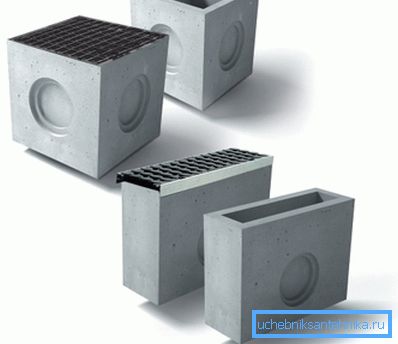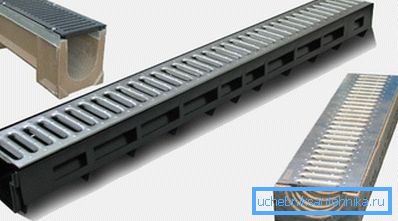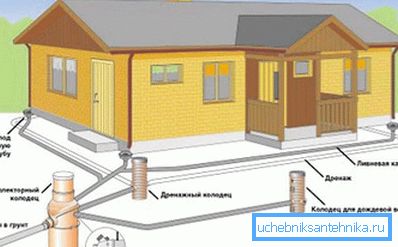Inlet wells their types and device
Removal of wastewater from the residential area is of great importance for landscaping. For these purposes, perform the whole system, an important element of which are storm water inlets. They come in all sorts of different types, for example, heavy rain inlets from prefabricated w / elements or light plastic structures, however, regardless of the type of device, all of them are designed for one thing - to discharge sewage from their accumulation sites.

The storm water intake is a container for collecting waste from different surfaces, which is connected to the general system for collecting waste. Next, we take a closer look at the device of rainwater wells, as well as their varieties.
General information
Harvesting rain and melt water, first of all, protects the house from the destruction of the foundation, preserves the blind area around the building, allows you to isolate the basement or ground floor from moisture and divert drains from the garage door. In addition, in addition to receiving wastewater, these devices trap various debris and fallen leaves, thereby preventing them from entering the sewer system (see also article Warming the well - if this is necessary and how to do it).

Types of inlets
For areas with high-intensity load, such as roads, industrial facilities, embankments, etc., use storm water inlets of concrete or metal. In other cases, for example, in the household plots, plastic or polymer products are used (see also the article Drainage pump for a well: features of the device and operation).
Now let's take a closer look at the features of each type of water intake.
From plastic
Plastic drainage basins are an excellent option for installation under the balconies of houses, near garages, or, as mentioned above, for arranging storm sewers in homestead plots. An important advantage of plastic products is the ability to install wells on each other, so that there is an opportunity to deepen the sewer pipe.
In addition, the prefab design allows the inlet to be used as a drainage well.
But besides this, the product has a number of other advantages, among which there are:
- The small weight of the structure, so that it is not difficult to transport;
- Due to the smooth surface, dirt does not linger on the walls, so the need to clean the well occurs much less frequently when compared to the concrete counterpart.
- Easy installation due to low weight. It will not be difficult to install such a well with your own hands. In addition, plastic gutters, as a rule, are supplied with all the necessary elements for their installation and operation.
- Frost resistance - the product is not afraid of frost and large temperature differences.
- The wells are made of high-strength plastic, so that they can withstand high pressure. In addition, they are not susceptible to the effects of various active chemicals.
- Low price.
- Environmental Safety.

Thanks to all these properties, the scope of application of plastic drainage systems is growing every day. Recently, they are actively used in parks, squares, as well as in car parks.
Metallic
No less common are metal wells for storm systems, which exist in various shapes and sizes. Especially often they are used in areas of large accumulations of wastewater, where there is a large load on the surface.
The size of the inlet well directly depends on the amount of water for which it is designed.
The advantages of such products include the following points:
- Ability to resist various negative environmental impacts.
- The ability to withstand a lot of weight.
- In addition, these wells have good durability.
However, despite all these advantages, metal structures are rarely used for private use, which is associated with some of their disadvantages:
- The cost of the product is several times higher than the price of a similar well made of polymer.
- Big weight of a design.
- Non-corrosion resistance.

Concrete
Concrete inlet well is a capital structure, which is built, as a rule, of precast concrete elements. Typically, such structures are used for industrial purposes.
On private estates to install concrete wells does not make sense due to some of their shortcomings:
- Large weight, respectively, complicated their transportation.
- For installation it is necessary to use construction equipment.
- High price.
Complete set of storm water inlets
In addition to the container itself (well), the gully contains other elements:
- Lattice;
- Filter cartridge;
- Trays;
Each element has its own purpose.

Lattices
In the complete set, there are always gratings to the inlet well, which are sometimes also called inlets. They pass water and do not allow the ingress of garbage into the system.
Lattices, like the containers themselves, can also be made of different materials:
- Cast iron - As it is not difficult to guess, cast-iron water inlets for wells are characterized by increased strength. They are able to withstand pressures up to 90 tons, so they can be seen on roads and other areas with increased load. As a rule, metal and concrete wells are completed with cast-iron gratings.
- Become - unlike cast-iron gratings, they have quite normal weight, and at the same time they are relatively inexpensive. Their only drawback is poor corrosion resistance.
- Plastics - products are resistant to environmental influences, but at the same time have less strength.
- Galvanized steel - today, these grates are considered the best option, as they combine the advantages of iron and steel products.
If the storm water inlet is designed as a closed inspection well, then a plastic hatch is used instead of a grating.
Tip! In addition to the functional value, the grilles perform a decorative function, as they are located on the surface. Therefore, when choosing them, one should pay attention to the appearance; there is a mass of decorative grids on the market, which can be a decoration of the site. For example, if there is a forging in the interior, cast iron products will look great.

Filter cartridge
For more thorough wastewater treatment, a filter cartridge is used for a storm-intake well, which must be cleaned periodically.
The cartridge consists of several elements:
- A basket in which dirt and sand sinks.
- Partitions that hold the basket and serve as a kind of odor trap from the well.
- Sealing base.
The assembly of the structure is as follows:
- The frame is mounted on the sealing base with a pin and poured around with concrete.
- Then the basket is mounted.
- A cast-iron or plastic lattice is installed on top of the frame.

Gutter trays
This element is a plastic channels that are used for surface drainage of water in the well.
The installation principle of these trays is the same as the well itself:
- A trench is being made with a slope to the well.
- The bottom of the trench is compacted and poured with concrete.
- Trays are laid and filled with concrete.
- Special trays are installed on top of the trays.
This system allows you to drain the tracks and flat areas, for example, in the courtyard in front of the house.
Tip! Additionally, you can purchase other accessories, for example, turns for channels, plugs, etc.

Installation of a storm water inlet
As mentioned above, to install a plastic inlet well is not difficult.
Installation instructions are as follows:
- First of all, a ditch is made for a well, which is larger in size than the structure.
- Then you must perform a compacted base of screening or sand. The height of such a pillow should be at least 10 cm.
- Next you need to fill the base with concrete.
- After that, a plastic water inlet is installed.
- Following is the installation of a storm pipe that discharges sewage, after which the well is set at the level.
- Then the concrete is poured on the sides of the well. The thickness of the walls should be about 10 cm.
Tip! To keep the structure tight, no additional fasteners should be made.

Conclusion
In many cases, the storm water inlet is a necessary element of a rainwater drain, on which not only the lack of puddles in the yard, but also the preservation of the whole house depends. Since its design is nothing complicated, when choosing a product, you should pay attention only to the material and its quality. The best variant of the well, for use in “household” purposes, as we found out, is the plastic product described above (find out here what to do if there is a float in the well).
Additional information on this topic can be obtained from the video in this article.